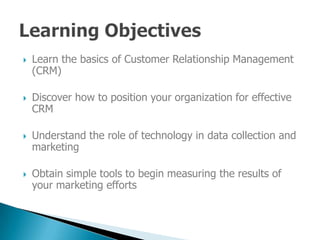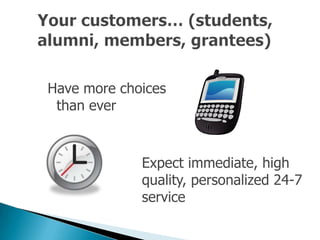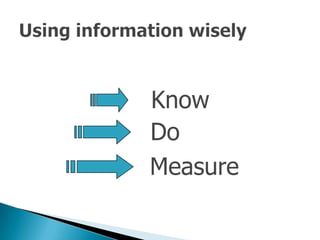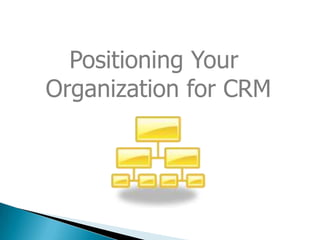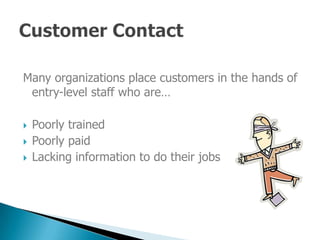Customer Relationship Management (CRM): Theory and Practice
- 1. J. Todd Bennett, Managing Partner decimal152 www.decimal152.com
- 2. Learn the basics of Customer Relationship Management (CRM) Discover how to position your organization for effective CRM Understand the role of technology in data collection and marketing Obtain simple tools to begin measuring the results of your marketing efforts
- 3. The Basics of Customer Relationship Management (CRM)
- 4. Have more choices than ever Expect immediate, high quality, personalized 24-7 service
- 5. Are expected to do MORE… with the same or FEWER resources
- 6. Plan, program, market, sell and service SMARTER With faster, better, more personalized Good service? Information
- 8. CRM is about… finding customers collecting info about them along the way using that info to enhance their experience and foster long-term relationships
- 9. Customer Product/Program offerings Marketing, Sales, Support Technology
- 10. What are their needs? Do you offer programs/products in response to their needs? …or your organization’s convenience?
- 11. Source: OSAT
- 13. Decision-making Information flow Customer contact
- 14. Many organizations place customers in the hands of entry-level staff who are… Poorly trained Poorly paid Lacking information to do their jobs
- 15. No longer just a communication channel Customers interacting with your site are interacting with your business Are the people creating your website’s content poorly trained, poorly paid and lacking information?
- 16. How do we bridge the customer information and interactions being collected on the front lines with decision- making throughout the organization?
- 18. The Role of Technology in CRM
- 19. CRM is a philosophy that is supported and enhanced by technology
- 20. dotCMS has the power to bridge islands of information
- 21. Before you worry about CRM, make sure your website: Is easy and intuitive to navigate, with a focus on customers’ information and task needs Provides up-to-date, well-written and accurate information
- 22. Present your potential customers with a seamless website experience. Avoid multiple, disconnected sites Avoid duplication of effort by integrating info from other systems Begin to bring everything you know about a customer together in one view
- 23. Customer account preferences and personalization of content Customer self-service Event management and registration E-communications tools
- 24. Customized catalogs and automated fulfillment Planning and tracking marketing campaigns Promotions and discounts Analytics and measurement Evaluation and follow-up
- 25. CRM, Marketing Strategy and Measurement
- 26. AWARENESS What do they know about you? INFO SEEKING Will you be on their short list? Consider the 4 Cs SHOPPING Customer, cost, convenience, communication PURCHASE How difficult do you make it?
- 28. Traditional Marketing Funnel Stranger strangers friends Friend shoppers Shopper Customer customers Loyal Customer
- 29. Prospects Prospects Alumni Inquiries Visitors Event Attendees Applicants Members Admits Volunteers Conference Attendees Matriculants Leaders Contributors Alumni
- 30. Goal is to move people through the funnel Success measured by conversion rate # people at one stage/ # people at the prior ◦ Conversion rates higher as you move down ◦ May vary by segment, program, strategy,etc. On avg 0.5% of strangers become customers
- 31. Need to track over time to establish baseline. Technology can help here. Start with educated guesses, refine with better data Once you know your conversion rates, you can better target your marketing strategies
- 32. You need 20 attendees for an upcoming seminar. Goal: Convert strangers to friends (get them to visit your website You plan to purchase a list and send postcards
- 33. How many postcards do you need to send? ◦ If you have tracked past conversion rates, this is easy
- 34. Convert the website visitors to shoppers ◦ Offer with registration? An incentive for them to create an account or log-in? This is your opportunity to build a customer’s profile. Convert shoppers to customers ◦ Follow-up with an email or phone call to seal the deal
- 35. Conversion rate alone not the best measure of success
- 36. A consistent, positive measure to compare success
- 37. Starts with Market Research ◦ What is your target market? Are there many? ◦ What are people in each market segment looking for? (needs, preferences) ◦ What do they know about you? How do they learn about you?
- 38. Identify market segments Match your program offerings to markets For each segment, develop specific strategies for each stage of the funnel Implement strategies, collect data, measure results Take what you learned and refine
- 39. Marketing plan is fluid Programming/ products should meet the needs of the customers Your past customers are your best future customers Your organization, programs, technology and strategies should evolve

